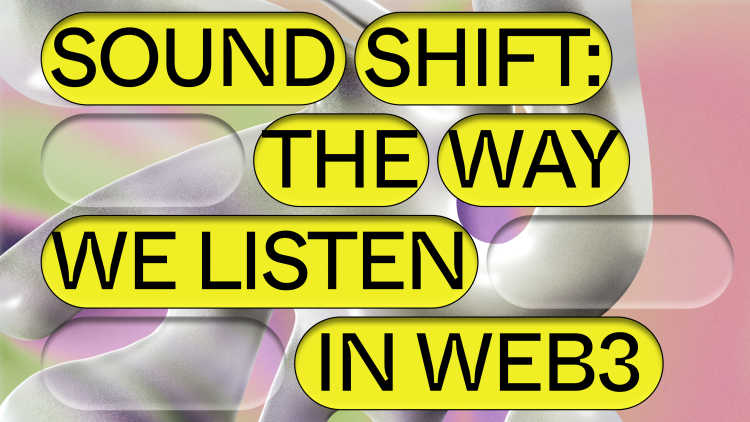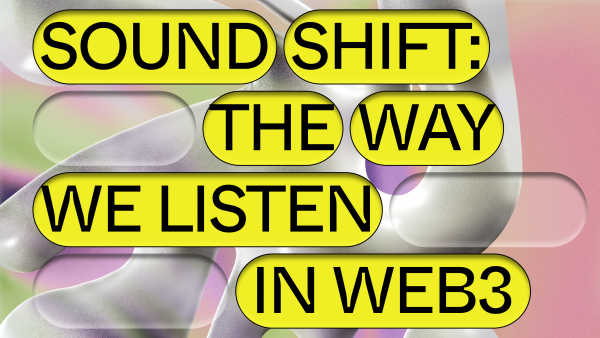The emerging landscape of NFT music.


Did you know that a virtual rabbit performed a set at SXSW & Art Basel?
Did you know that Warner Music just launched a Web3 music label?
Did you know that Coachella used NFTs to power festival access?
If any of this is news to you, or you’re fascinated by why any of this matters: keep reading, because we’re going to dive deep into the emerging world of music NFTs.
Music NFTs are exploding.
Whether it's major labels like UMG backing a band of Apes, Opensea debuting their drop platform with acclaimed rappers, or independent artists in the headlines for earning 1000X streaming revenue: it’s undeniable that music NFTs have broken into the mainstream. To date, there have been 4,500 unique music NFT drops, accounting for over 2 million tokens and $182 million in revenue. (Source: Water and Music) We’re witnessing a watershed moment in music; one with far-reaching cultural, creative, and commercial impact.
Why should you care about music NFTs?
Whether you're an artist, or a fan, digital music is broken. You can hear it. Skewed incentive models generate tracks for the algorithm, rewarding homogeneity over experimentation. And you can feel it. Musicians are fighting for the viability of their work in a post-streaming, post-Covid landscape. The internet promised creators autonomy and options. But increasingly, they’re confronted with real constraints around what they can make, and how they can monetize their work.
In short, artists want remuneration, the right to express their full creativity, and to retain ownership of their work. Music NFTs provide a means to achieve all that, and then some.
What are music NFTs?
In their simplest form, music NFTs are tokenized songs minted on chain. But the creative potential is far more expansive. Projects like WVRP Sounds explore generative music as identity. Rituals expands upon the IRL aspect of listening. Orbs by BT invokes music as a living object. We’re talking about way more than WAVs here. On chain, a record can be a 1/1 artwork. It can be a collectible. An avatar. An access pass. Music NFTs open up an unprecedented opportunity: the chance to reimagine how we experience sound.
The rise of web3-native artists.
The NFT landscape is young. The music NFT system is even younger, making it rich ground for experimentation. Here, cryptonative musicians are finding success by building subculture. For these artists, it’s not about chasing playlists or 360 deals. It’s about building a core community that has a stake in your success.
This movement has precedent in an established framework: 1,000 True Fans. Kevin Kelly’s 2008 essay theorized that the internet would allow artists to make a living off their work. In this model, depth is more important than breadth.
With the emergence of web3-native creator tools, the threshold for success has downshifted. You no longer need 1,000 true fans. Maybe you only need 100. Today, artists can make more money off of fewer fans, by placing emphasis on exclusive access, interactions, and experiences that drive value back to the community. These true fans aren’t just passively consuming content, they’re earning a stake in a shared cultural project. That’s a monumental shift. Your community, your fans, are incentivized to see you succeed.
A growing number of breakout artists have put this model to the test, and proven it out. Artists like LaTasha, Verité, and collectives like SongCamp and HUME are committed to nurturing and adding value to their communities. In turn, their projects have been met with breakthrough success; realizing far more revenue than traditional streaming.
Major artists enter the chat.
Music NFTs aren’t just for cryptonative artists and experimental musicians. From Bowie to Coachella: the past two years have seen festivals, majors, and some of music’s biggest names, launch NFT projects.
Low Fi legend OMGKirby has released several NFT projects, including his genesis collection that helped pioneer the formula for Music PFPs: the visual uses a looping scene featuring various elements that represent the song’s stems; genesis holders have DAO access. September saw the artist launch Opensea’s Seadrop platform, with celebrated rapper Channel Tres.
3LAU, one of the world's biggest electronic artists, has been highly active in the space since 2020. Last year, he launched his own platform, Royal, to allow fans to buy a piece of the royalties generated from their favorite artists, including the Chainsmokers, with a drop earlier this spring.
Following a major change to the UK’s Official Charts Company, Muse released their 9th studio album as an NFT through the Serenade platform, becoming the first NFT album release eligible for UK & Australian charts.
And artists like Pussy Riot and Salem Ilese used music NFTs to fund social impact campaigns. May’s Crypto Boy drop generated 84 ETH, with 100% of proceeds donated to The Center For Reproductive Rights.
Of course, we can’t talk about music NFTs without mentioning Snoop Dogg, who’s gone hard in the space, dropping Back On Death Row in collaboration with Gala Music, releasing CC0 tracks on Sound.xyz, co-creating the premium “Studio Snoop Dogg” Burrow for Fluf World’s genesis land collection. He’s even gone as far as removing the entire Death Row catalog from streaming services; a move that many speculate precedes a greater web3 music strategy from the label exec.
The emergence of meta-stars.
But you don’t need to be human to make a name for yourself in web3 music. There’s a clear path to a future where virtual influencers top the NFT charts. Angelbaby has already performed at Art Basel, SXSW & alongside T-Pain at Fluff Haus LA. If that’s not wild enough, the songs they’ve released so far have been some of the best performing tracks ever featured on Audius, a Web3 streaming platform & have even featured production from multi-platinum producers like Gino.eth, FKA GinoTheGhost.
Speaking of Gino, he’s got his own NFT project, Blocktones, connected to HUME and wider Fluf World lore. Not many details are available yet, but so far they’ve built a rich, detailed experience inspired by mint mechanics; imagining a future where all music is made by AI.
Established projects like Bored Apes have launched meta-stars like Timbaland’s Congo & Kingship, a UMG backed band founded by Celine Joshua & Jimmy McNelis. Though the collection has only been out for a few months, the band has already debuted a collab with M&Ms & appears to have production from James Fauntleroy, Hit Boy & others.
And emerging projects like Rhoki point to a reimagining of what music might mean: as lore and as a storyworld created through community participation.
Distributing music in web3.
The thought of Snoop reissuing his label’s entire collection on chain may seem extreme or impractical, but the tools are already in place to make this a reality. Instead of working with labels, musicians can use NFTs to bring their music directly to fans, with control and autonomy over every aspect of the release.
Now, there are more options than ever before for artists looking to issue music NFTs. Sound.xyz centers the relationship between artists and their community; emphasizing ownership and early support among fans. Zora allows artists to create storefronts for their songs. Catalog works like a digital record shop; supporting 1 of 1 mints, with artists receiving 100% of sales revenue. Nina Protocol allows artists to host music for free streaming, to sell digital editions and retain 100% of all proceeds, and to create fan experiences, with the recognition that there’s no single model for creative monetization. Even Limewire is back in the mix.
A new model for record labels.
Historically, record labels held immense power; acting as gatekeepers for distribution. Web1 introduced DIY distribution, but labels retained value and influence: providing artists with financing, sync licensing, touring infrastructure, and more.
While a growing number of artists are adept at marketing and self-distribution, many still see the need for mentorship. Realizing things could be done differently, Troy Carter & Suzy Ryoo launched an NFT membership pass for their platform Venice Music, an all-in-one hub for artists that provides distribution, educational workshops, networking events, and access to sync placements for higher-tier members.
In October, Warner Music and Probably Nothing announced a partnership and a mission to build web3’s first major label. On the other end of the spectrum, HUME is exploring what happens when fans, not just record execs, have a seat at the table. The community-governed label grants Genesis NFT holders the right to vote on key decisions for the label’s roster of meta-stars.
Challenges to mainstreaming music NFTs.
Music NFTs are a fast-growing segment of the marketplace. But there are hurdles to broad adoption, beyond the macroeconomic environment.
The creative potential of music NFTs as deep, integrated experiences presents complexity.
Compared to PFP projects, there’s not necessarily an immediate mechanism for fan display and marketing. The technical barrier to entry on production is higher, with fewer out-of-the-box creator tools.
Moreover, the landscape as a whole is fragmented. There’s no agreed-upon standard for publishing on chain in a way that’s both monetizable and discoverable. But a number of new experiments lay out a path for progress.
Projects like Formless’ Share Protocol, an engine for web3 pay-per-streaming show promise for more frictionless revenue. No code minting via Creator HQ may help broaden access to NFT publishing. And infrastructure for music NFT aggregation will improve fan experience: Future Tape, launched in September, allows fans to play songs minted across Catalog, Sound.xyz, Nina Protocol, Mint Songs, and Zora.
The dawn of a new medium for artists.
We’re in the relatively early days of a new medium for music. Which means that with all the complexity, chaos, and upheaval, we can also begin to see the promise of this new world come into focus. According to FreeYourMusic, one million streams of a song on Spotify pays out approximately $5K. The average sales price of a song minted on Catalog is approximately 1 ETH. If you’re an artist, you could try to get to 1M streams. Or, you could try to sell 4 NFTs. : )
More than the economics, music NFTs present artists with a new canvas: one that’s dynamic, uniquely collaborative, and community-driven. Above all else, they represent the chance for us to shape the way songs are experienced. Which sounds good.







